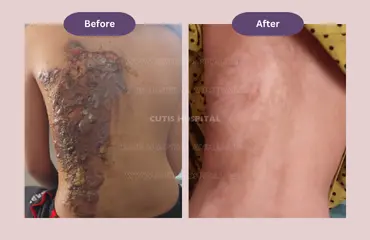Skin is the largest organ. It regulates body's temperature, protects against infections, and prevents evaporation of bodily fluids. Any injury like flame burns quickly causes a life-threatening emergency. Damage resulting from such burns is severe, as it leads to long-term impairment of bodily functions and illnesses. However, with suitable burn treatment, the skin can be healed, and the patient can return to life with rehabilitation.
A burn injury that damages the skin layers is caused by exposure to flames or fire. It’s a third-degree burn injury, which damages all the layers of the skin, fat, and muscle.
Scald – A burnt wound caused by spilling a hot liquid. The longer the contact and thicker the liquid, the scald is greater.
Contact burn – A wound caused when the skin contacts a hot object. The burn is located locally and heals quickly within 5 days. Examples: burns from cooking appliances, irons, or from cigarettes.
Electrical burns – These are very deep burns caused by electricity. They usually are severe as the skin and tissue are damaged.
Chemical burns- Contact with flammable liquids or gases cause damage to the airways, causing breathing problem.
Sunburn – The skin appears red and may get rashes caused by ultraviolet (UV) rays of the sun. These burns are caused during sunbathing and tanning bed.
First degree burns – Often referred to as superficial burns, these are the mildest. Such burns only damage the first layer of skin (epidermis). The skin becomes red and heals within 5 days. No scar or infection is seen at the site.
Second degree burns - Often referred to as partial thickness burns and are mediocre. Such burns damage both the epidermis and the second layer of skin (dermis). They are painful, appear swollen and red, often with blisters.
Superficial second-degree burns – Do not scare and heal within 2 weeks.
Deep second-degree burns: Scar and require more time to heal. Often surgery is needed based on location and size of the burn.
Third degree burns- Often referred to as full thickness burns. The damage is severe, as it impacts all layers of skin and muscles. Injury site is charred, white/black/deep red in color, and usually numb. These wounds don’t heal and require skin grafting.
Fourth degree burns - The damage is severe, as it impacts muscles, fat, and bones. The victim’s survival rate is negligible.
To analyze the severity of the burn and apply suitable flame burns treatment, a diagnosis is done – based on the "rule of nines."
So, what does this rule say?
The degree of the burn is determined by 9% of the surface area and its multiples. Thus, each arm is 9% of the body surface area, each leg is 18%, the head and neck are 9%, the back and front of the torso are 18%, and the genital area is 1%.
By using this rule, the burnt specialist can arrive at a precise conclusion.
Additionally, the doctor may perform urine and blood tests to detect proteins and monitor electrolytes caused by destroyed muscles in flame burns.
Treatment is done to reduce swelling and pain, prevent infection, and encourage healing.
Wound dressing is applied to the burnt site for up to 14 days or until the healing is complete. Antibiotic ointment and a dressing should be applied to the donor site for healing. If experiencing pain, newly open areas, redness, and warmth in the site, immediately consult the burn specialist.
Flame burns treatment plan focuses on healing the wound, reducing pain, and returning to life. Thus, patients must strictly follow the aftercare procedure prescribed by their doctor and physiotherapist.
We specialize in flame burns treatment; hence we have dedicated ICU, isolation ward, and operation theatres for burn patients. Our specialized surgeons, anesthesiologist, and plastic burn surgeons along with medical staff provide quality care to patients. Physiotherapy and occupational rehabilitation help them return to active life.


Healing time depends on the type, size, and location of the burn. First-degree burns heal quickly, while third-degree burns like flame burns takes several weeks and/or months to heal.
Burns serious than a first-degree should be immediately seen by a specialist in a burn specialty hospital.
Depending on the level of the burn, some can be treated at home while others need to be quickly seen by a burn specialist.
In case of first-degree burns immerse it in cool tap water or apply a wet compress, never use ice or ointments else blisters will be formed. If blisters are formed allow them to heal naturally, popping them will increase chance of infection. To reduce pain and inflammation, use over-the-counter pain medication.
Deep burns cause scarring, disfigurement, discoloration, pain and itching on the skin. The skin may become less elastic and overly sensitive to sun. Survivors need to undergo multiple skin grafting surgeries to improve their condition.
Cutis Hospital is conveniently located in Ghatlodia, Ahmedabad, making it easily accessible via multiple modes of transportation. Below are the various ways you can reach our facility:
Sardar Vallabhbhai Patel International Airport: Located approximately 12.7 km from Cutis Hospital, offering convenient access for patients traveling from outside the city.
Chandlodiya Railway Station: Approximately 2.4 km from Cutis Hospital.
Ahmedabad Railway Station: Around 11 km from our center.
GSRTC:
Ahmedabad Central Bus Station (GSRTC): About 10.3 km from the hospital.
AMTS:
Bhuyangdev Cross Road Bus Stop: Just 500 meters from Cutis Hospital.
BRTS:
Bhuyangdev BRTS Bus Stop: Only 170 meters from our center.
We provide effective surgical and non-surgical treatments for all parts of the body. At Cutis Hospital, our cosmetic and plastic surgery team is committed to giving patients safe and high-quality care.